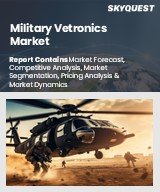
세계의 군용 베트로닉스 시장 규모는 2023년에 90억 달러로 평가되며, 2024년 93억 2,000만 달러에서 2032년에는 123억 7,000만 달러로 성장하며, 예측 기간(2025-2032년)의 CAGR은 3.6%로 성장할 전망입니다.
세계 군용 베트로닉스 시장은 국방 예산 증가, 현대화 계획, 센서 및 자동화 시스템 강화 등 기술 발전에 힘입어 크게 성장하고 있습니다. 지정학적 긴장이 고조되면서 각국의 기술 인프라, 특히 베테로닉스 시스템의 업그레이드를 촉진하고 있습니다. 시장에 영향을 미치는 주요 동향으로는 기술 혁신, 차량 현대화, 상황 인식 능력을 향상시키는 전자 시스템 통합 개선 등이 있습니다. AI와 머신러닝을 활용한 차세대 동물용 로봇의 등장과 국방 관련 기업과 하이테크 기업의 협업이 시장 확대를 더욱 부추기고 있습니다. 그러나 높은 통합 비용, 신흥 시장에서의 예산 제약, 사이버 보안 문제, 규제 준수 문제 등이 시장 침투와 매출 성장에 걸림돌로 작용하고 있습니다.
Global Military Vetronics Market size was valued at USD 9.0 billion in 2023 and is poised to grow from USD 9.32 billion in 2024 to USD 12.37 billion by 2032, growing at a CAGR of 3.6% during the forecast period (2025-2032).
The Global Military Vetronics market is experiencing significant growth fueled by increasing defense budgets, modernization initiatives, and advancements in technology, including enhanced sensors and automated systems. Rising geopolitical tensions drive nations to upgrade their technological infrastructure, particularly in vetronics systems. Key trends influencing the market include technological breakthroughs, vehicle modernization, and improved integration of electronic systems that heighten situational awareness. The emergence of next-generation veterinary robots utilizing AI and machine learning, along with collaborations between defense contractors and tech companies, are further boosting market expansion. However, challenges such as high integration costs, budget constraints in developing nations, cybersecurity concerns, and regulatory compliance issues continue to impede market penetration and revenue growth.
Top-down and bottom-up approaches were used to estimate and validate the size of the Global Military Vetronics market and to estimate the size of various other dependent submarkets. The research methodology used to estimate the market size includes the following details: The key players in the market were identified through secondary research, and their market shares in the respective regions were determined through primary and secondary research. This entire procedure includes the study of the annual and financial reports of the top market players and extensive interviews for key insights from industry leaders such as CEOs, VPs, directors, and marketing executives. All percentage shares split, and breakdowns were determined using secondary sources and verified through Primary sources. All possible parameters that affect the markets covered in this research study have been accounted for, viewed in extensive detail, verified through primary research, and analyzed to get the final quantitative and qualitative data.
Global Military Vetronics Market Segments Analysis
Global Military Vetronics Market is segmented by Product Type, Platform, Application, Component, Technology and region. Based on Product Type, the market is segmented into Communication & Navigation Systems, Power System, Display System, C4 Systems and Others. Based on Platform, the market is segmented into Unmanned Ground Vehicles, Armored Amphibious Vehicles, Light Protected Vehicles, Special Purpose Vehicles, Land Vehicles, Naval Vehicles, Aerial Vehicles and Others. Based on Application, the market is segmented into Command and Control Systems, Communication Systems, Navigation Systems, Surveillance Systems and Weapon Control Systems. Based on Component, the market is segmented into Display, Sensors, Control Management Systems, Power Supply Systems and Computing Units. Based on Technology, the market is segmented into Electronic Welfare, Software and Cybersecurity, Network Solutions and Artificial Intelligence. Based on region, the market is segmented into North America, Europe, Asia Pacific, Latin America and Middle East & Africa.
Driver of the Global Military Vetronics Market
The Global Military Vetronics market is primarily fueled by the upward trend in defense budgets worldwide, with nations channeling resources into the modernization and enhancement of their military forces. This surge in spending allows for the acquisition of advanced vehicles equipped with sophisticated systems for communication, command, control, and surveillance. Governments are prioritizing investments in critical areas such as artificial intelligence, cybersecurity, and autonomous technologies to bolster combat effectiveness and operational readiness. Such financial backing facilitates extensive integration of vetronics across various platforms including land, air, and naval operations, thereby sustaining the ongoing expansion of the market on a global scale.
Restraints in the Global Military Vetronics Market
The Global Military Vetronics market faces considerable limitations due to the substantial financial commitment necessary for modernizing military vehicles with advanced vetronics technologies, including power control, navigation, and communication systems. The stringent military standards that these systems must meet, encompassing factors like security, electromagnetic compatibility, and durability, significantly contribute to escalating costs. As a result, budget constraints can hinder the adoption of the latest technologies, making it challenging for defense organizations to implement necessary upgrades effectively. This financial burden poses a challenge to sustaining growth and innovation within the military vetronics sector.
Market Trends of the Global Military Vetronics Market
The Global Military Vetronics market is witnessing a significant trend towards the integration of AI and Machine Learning technologies. These advancements are enhancing the capabilities of vetronics systems by enabling sophisticated threat detection, autonomous navigation, and predictive maintenance. Consequently, military operators experience reduced workloads, allowing them to focus on strategic decision-making. Furthermore, the incorporation of these technologies contributes to increased operational efficiency and effectiveness in combat situations. As defense organizations prioritize innovation, the demand for advanced vetronics systems that leverage AI and Machine Learning is expected to surge, driving market growth and shaping the future of military technology.